
Chornobyl NPP safety at risk: History of protective arch and its ability to withstand impacts
On the night of February 14, a Russian attack drone with an explosive warhead struck a shelter over the fourth power unit of the Chornobyl nuclear power plant. A fire broke out but was quickly extinguished. While the damage to the protective structure was significant, the radiation level remained within normal limits. President Volodymyr Zelenskyy described the attack as another "greeting from Putin," highlighting it as a demonstration of his true stance on the peace agreement that the new administration in Washington is pushing for
Contents
- Another Russian terrorist attack: Scaring the world ahead of the Munich Conference
- How the Chornobyl Nuclear Power Plant was built and what led to the tragedy?
- How the Chornobyl fire was extinguished and the sarcophagus construction began
- Why the first sarcophagus collapsed and the development of the new safe confinement
- Key features of the New Safe Confinement
Espreso will revisit the history of the Chornobyl nuclear power plant, explaining the cause of the tragedy and detailing how the unique shelter project was carried out over the site.
Another Russian terrorist attack: Scaring the world ahead of the Munich Conference
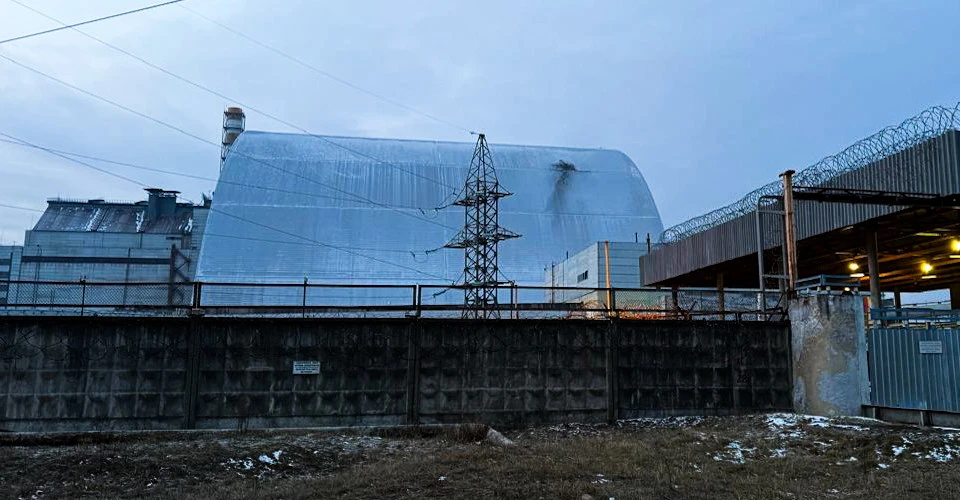
On the first day of the invasion, Russian troops captured the Chornobyl nuclear power plant and held it for over a month. During this occupation, incidents of looting and violations of radiation safety protocols were reported. From the outset of the full-scale war, the Russians made it clear that they would resort to any means necessary to achieve their aggressive goals, even if it risked a global catastrophe. Additionally, Russia has been holding Europe's largest nuclear plant, the Zaporizhzhia NPP, hostage for nearly three years, with periodic emergencies occurring there.
Thus, the recent drone strike on the Chornobyl dome serves as another alarming sign of the terrorist threat posed by Russia. The drone flew at an altitude of 85 meters, allowing it to evade radar detection. This suggests that the strike on the Chornobyl sarcophagus was deliberate, not accidental. Furthermore, the wreckage of the drone and its serial number confirm its Russian origin — it was a Geranium-2, Russia's version of the Iranian Shahed.
As expected, the Kremlin denied the attack, dismissing reports of a strike on the Chornobyl nuclear power plant as “provocations before the Munich conference.” However, experts point out that this is a typical Russian tactic — accusing Ukraine of actions they themselves are responsible for.
“This is a provocation by Russia ahead of the Munich conference. A drone carrying a high-explosive bomb deliberately targeted a shelter facility. Moreover, it struck an area not above the destroyed fourth reactor unit, where an old shelter still exists and needs to be dismantled,” said Olha Kosharna, an expert on nuclear energy and safety, in an interview with Espreso.
Although this strike did not cause an increase in radiation levels (which can be monitored online here), any damage to the protective structures of the Chornobyl NPP carries potentially catastrophic risks. When these structures were designed, they did not account for the possibility of drones carrying mines being fired at them.
“It was designed to withstand extreme events like severe weather, but it would not survive a missile strike,” Simon Evans, former head of the Shelter Fund, remarked a few years ago.
The sarcophagus was constructed over the decaying old shelter, which was built over the destroyed reactor, containing the effects of the remaining radioactive materials. If the structure becomes unstable, it could lead to a collapse and the release of radiation, posing a threat not only to Ukraine but also to neighboring countries.
The drone strike has compromised the integrity of the Chornobyl shelter, meaning that new engineering and technical solutions will be necessary to repair it, along with funding to patch the damaged shell.
“The Chornobyl shelter is designed and required to contain the vast radioactive contents of the unit 4 reactor. It’s not just a roof but a massive, sophisticated machine designed specifically to prevent the release of radioactivity into the environment. And now Russia has hit it with an explosive, penetrated the steel roof and caused a fire. How long will Russia’s targeting of Ukraine’s nuclear plants – including its occupation of the Zaporizhzhia plant and its war crimes – be allowed to go unpunished?” said Shaun Burnie, nuclear specialist at Greenpeace Ukraine.
According to Andriy Yermak, the head of the Office of the President of Ukraine, during the security conference in Munich, where politicians from around the world gathered to discuss the Russian-Ukrainian war, “everyone is very angry about this news.”
“Not ‘concerned,’ as is often the case, but really angry. In the 80s, the whole world helped the Kremlin to address this tragedy. When Moscow exposed unprotected people to radiation, Gorbachev received robots, equipment, and scientists. Then the entire world invested in the shelter, and today these Russian idiots launched a drone at it,” Yermak stated.
However, the IAEA only confirmed the attack on the plant but, as has become typical, did not assign blame to Russia.
How the Chornobyl Nuclear Power Plant was built and what led to the tragedy?
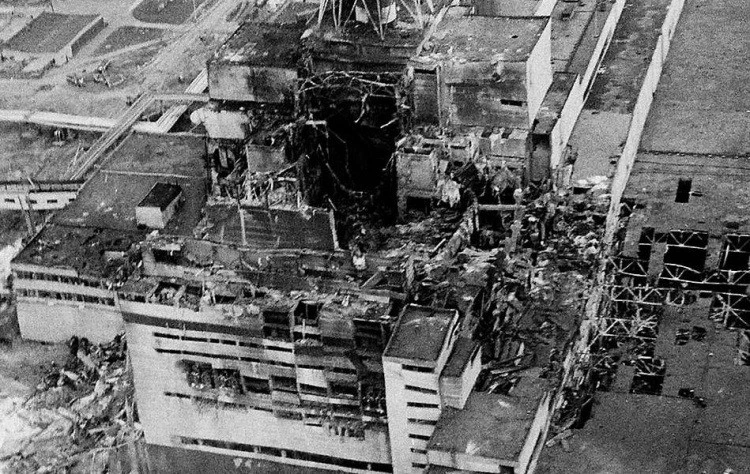
Chornobyl NPP Unit 4 three days after the explosion, photo: Chornobyl disaster
To understand the history of the Chornobyl nuclear power plant, it's important to look back at the Second World War, which not only resulted in the deaths of tens of millions and widespread destruction but also triggered a rapid technological advancement.
The advent of nuclear technology was a double-edged sword: on one side, the devastating atomic bombs, and on the other, the promise of cheap nuclear energy.
It was the Soviet Union that launched the world's first nuclear power plant in 1954 in Obninsk, Russia, marking a significant propaganda victory during the Cold War against the United States and Western countries. This development of nuclear energy in the Soviet Union was not only economically vital but also carried military and political significance.
In the 1960s, a global nuclear energy boom took off as nuclear power plants began to sprout across the world. During this period, the USSR was rapidly developing heavy industry, which created a growing demand for electricity. The coal industry could not fully meet these needs, so nuclear power emerged as a solution, enabling the creation of high-performance power plants. As a result, the decision was made to build numerous nuclear reactors, many of which were never completed, such as those planned for Crimea.
Ukrainian nuclear energy began with the Chornobyl nuclear power plant in the Kyiv region. Construction commenced in 1970, and the first power unit was launched in 1977. A new town, Prypiat, was built from scratch just two kilometers from the plant to house its employees — now a ghost town.
By the time of the Chornobyl disaster, the plant had four operational power units with RBMK-1000 reactors. Plans were in place to complete two more units, but following the disaster, construction on these additional reactors was halted.
Many people believe that the 1986 Chornobyl accident was the first of its kind in the USSR. However, in reality, a large-scale nuclear waste accident had already occurred in 1957 at the MAYAK chemical plant in the Chelyabinsk region, affecting around 300,000 people. Despite this, the Soviet regime managed to keep the tragedy in the Urals hidden for over 30 years. In contrast, the scale of the disaster at Chornobyl made it widely known almost immediately.
The accident occurred on the night of April 26, 1986, during a test experiment at Unit 4. The purpose of the test was to determine if the turbine generator could provide electricity for a short time in the event of a blackout. Instead, an explosion took place.
The tragedy had numerous causes, ranging from design flaws in the reactor to human error, which led to a critical violation of safety protocols. Ultimately, the thermal explosion that destroyed the reactor and released vast amounts of radioactive material into the atmosphere served as a stark reminder to humanity of the dangers of nuclear technology when safety measures are not properly followed.
The radiation cloud from the Chornobyl disaster spread across parts of Ukraine, Belarus, Russia, and several other European countries. Over 600,000 liquidators were involved in addressing the aftermath of the accident, many of whom were exposed to high doses of radiation, leading to illness and death in the years that followed.
In response to radioactive contamination, around 116,000 people were evacuated from the 30-kilometer zone, with an additional 230,000 resettled later. According to WHO estimates, tens of thousands of deaths were caused by cancer and other radiation-related complications, while thousands of infants were born with pathologies, with the incidence of these conditions significantly increasing after the accident. Additionally, parts of the land became almost permanently unusable and were incorporated into the exclusion zone.
How the Chornobyl fire was extinguished and the sarcophagus construction began
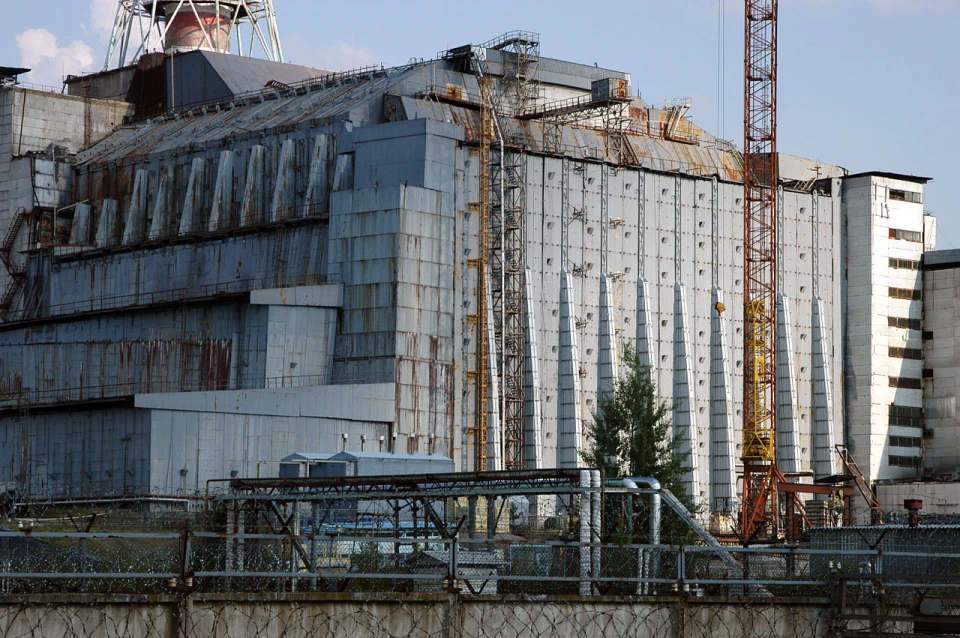
After the explosion at the fourth power unit of the Chornobyl nuclear power plant, a massive fire engulfed the plant. Firefighters from Prypiat were the first to arrive at the scene, attempting to extinguish the flames without proper protective gear. They worked in conditions with lethal radiation levels, unaware of the full extent of the danger, as the Soviet regime sought to conceal the situation until the very end.
By the morning of April 26, the fire was localized, but the main threat remained: molten graphite and uranium fuel inside the reactor continued to burn, releasing radioactive dust into the air. To reduce emissions, helicopters dropped tons of sand, lead, boron, and dolomite onto the reactor in an effort to extinguish the fire and absorb radiation. However, these measures only partially alleviated the situation, as the mixture continued to heat up, posing the risk of a breakthrough into the sub-reactor rooms.
To prevent an even greater catastrophe, a tunnel was dug beneath the unit to install a cooling system. A team of miners manually excavated an underground corridor that allowed them to pour a concrete slab beneath the reactor, effectively preventing further damage. Meanwhile, thousands of liquidators worked tirelessly to decontaminate the area, clear the wreckage, and reduce radiation levels.
At the same time, construction began on the sarcophagus to entomb the waste and reactor. Around 90,000 workers were involved in the project, constructing the structure over six months under extreme conditions. Engineers and workers operated in short shifts, using robotic equipment that frequently malfunctioned due to high radiation levels. By November of the same year, the installation of a concrete and metal shelter, known as the Shelter, was completed over the destroyed reactor. The project required 400,000 cubic meters of concrete and 7,000 tons of metal structures.
Although the sarcophagus was far from a perfect solution and had several limitations, it effectively reduced radiation contamination and prevented the further spread of radioactive materials. This allowed for the initiation of long-term efforts to mitigate the aftermath of the disaster.
After the accident at Unit 4, operations at Chornobyl NPP were suspended. However, with the completion of the Shelter, Units 1 and 2 were restarted, and Unit 3 was restored a year later. It wasn't until December 2000 that the Chornobyl NPP was fully shut down.
Why the first sarcophagus collapsed and the development of the New Safe Confinement
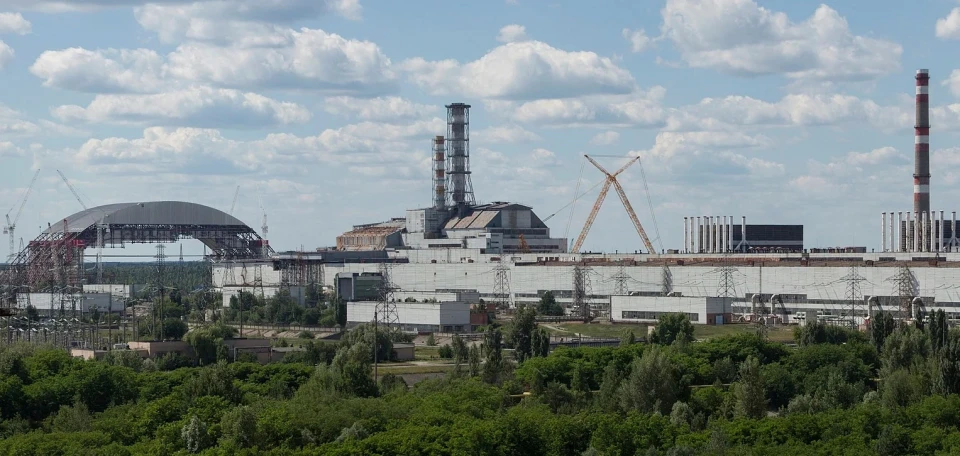
The Shelter was intended as a temporary solution. The engineers who designed it estimated it would last 20 to 30 years, but in reality, its degradation occurred much more rapidly.
Due to the rush and harsh conditions during construction, the structure had several flaws. It was made of metal and concrete elements, some of which rested on the destroyed walls of the reactor, making the shelter unstable. Over time, the strength of the shelter gradually diminished due to the combined effects of radiation, weather conditions, and corrosion.
By the 1990s, it became clear that the sarcophagus would not be able to contain radioactive materials for much longer. In certain areas, the internal radiation levels reached 10,000 roentgens per hour, while the normal radiation background in cities is typically around 20-50 micro roentgens per hour.
In 1997, at the initiative of the G7 countries, the Chornobyl Shelter Fund was established to create conditions for dismantling radiation-contaminated structures and constructing new protective measures. International experts had confirmed the risk of the old structure collapsing, which could lead to the release of radioactive substances. As a result, the decision was made to develop a new shelter design — the New Safe Confinement — that would fully cover the emergency reactor and the old sarcophagus.
The initial work focused on constructing metal reinforcement structures to stabilize the existing Shelter and prevent a collapse that could release harmful radiation. This stabilization process took place in several stages and was completed by 2007.
In 2004, the European Bank for Reconstruction and Development issued a tender for the design, construction, and commissioning of a new sarcophagus for the Chornobyl NPP. The tender was won in late 2007 by the French consortium Novarka, which agreed to build a new arch-shaped protective shelter.
The company began work in the fall of 2010. In total, up to 8,000 people were involved, though only about 3,000 worked on-site in shifts to ensure that radiation exposure limits were not exceeded.
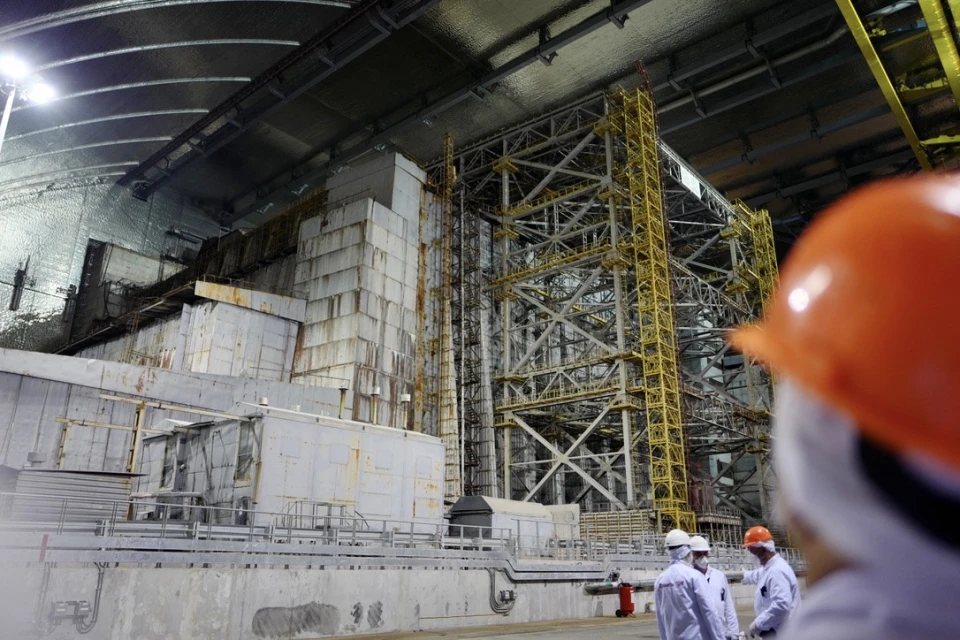
One of the unique aspects of the project was that the new sarcophagus was built 180 meters away from the Shelter to minimize personnel exposure to radiation. A special platform with rails was created to allow the massive arch to be moved into place using hydraulic mechanisms after construction was completed.
By 2016, the arch had been fully assembled, and in the same year, hundreds of hydraulic jacks pushed it into place over the old sarcophagus. This made it the largest movable steel structure in the world. However, it took another two years for all necessary tests to be completed, and the new sarcophagus was officially put into operation in July 2019.
The total cost of the project exceeded €2 billion, with contributions from 27 countries.
Key features of the New Safe Confinement
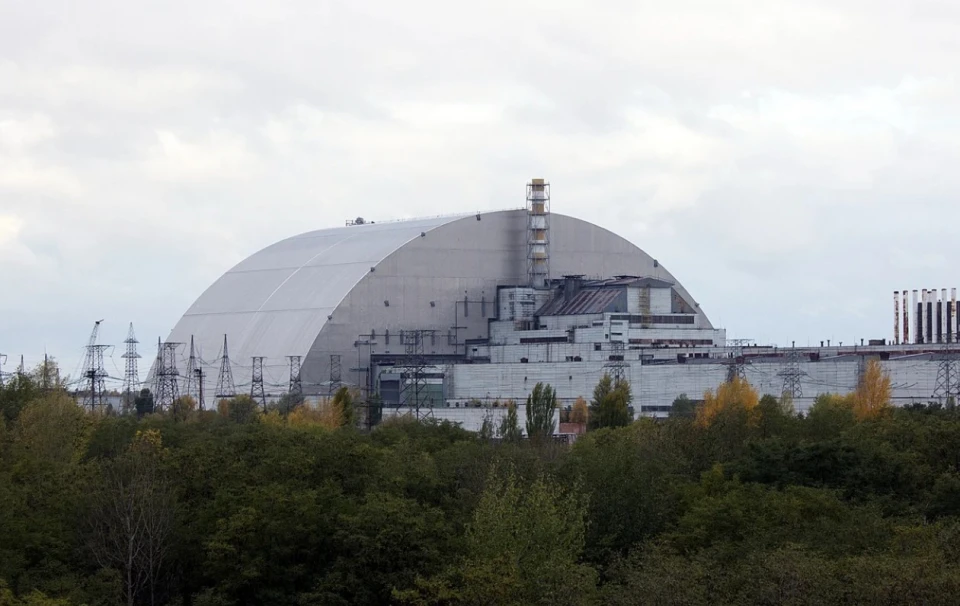
The New Safe Confinement is a unique engineering structure designed to completely cover the fourth reactor of the Chornobyl NPP, preventing further radioactive contamination.
The shelter’s defining feature is its enormous arched design. It stands 92.5 meters tall—about the height of a 30-story building—while spanning 260 meters in width and 150 meters in length. The total weight of the structure exceeds 36,000 tons.
Thanks to its massive size, the confinement fully encloses the destroyed reactor while leaving enough space inside for future dismantling of hazardous structures. To put its scale into perspective, the new shelter is taller than both the Statue of Liberty and Big Ben. Although it is shorter than the Eiffel Tower, the BBC notes that the amount of metal used for its construction could build three such towers.
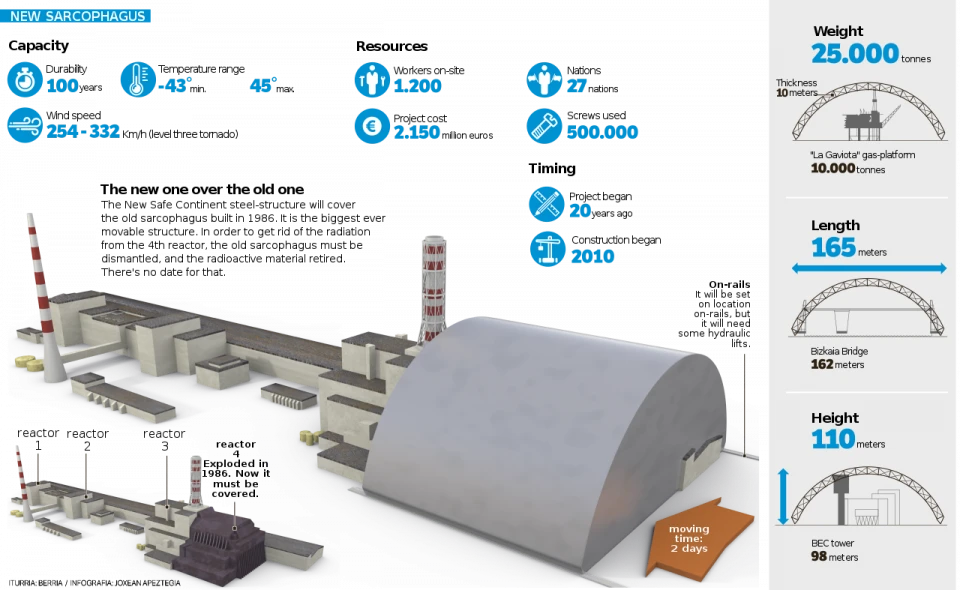
The frame of the New Safe Confinement consists of tubular steel elements covered with three-layer "sandwich" panels that ensure reliable insulation. Inside the arch, polycarbonate panels prevent radioactive dust from settling on the metal structures. Additionally, warm, dry air circulates between the outer walls to prevent condensation and corrosion, prolonging the shelter’s lifespan.
The structure is designed to withstand extreme conditions, including powerful tornadoes and temperatures ranging from -43°C to +45°C.
Beyond its protective function, the shelter is equipped with advanced ventilation, remote control, and monitoring systems. Special cranes and robotic equipment enable the safe dismantling of the remains of the old sarcophagus and facilitate long-term decontamination efforts.
The New Safe Confinement stands as the largest movable structure in the world and serves as the primary safeguard for future generations. Engineered to last at least 100 years, it ensures control over the Chornobyl ruins while scientists and engineers continue working toward the final elimination of the disaster's consequences.
Despite these efforts, the remnants of the catastrophe will remain hazardous for generations. The land surrounding Chornobyl is expected to take up to 100,000 years to be fully cleared of radiation, making it one of the longest-lasting environmental challenges in human history.
- News













































